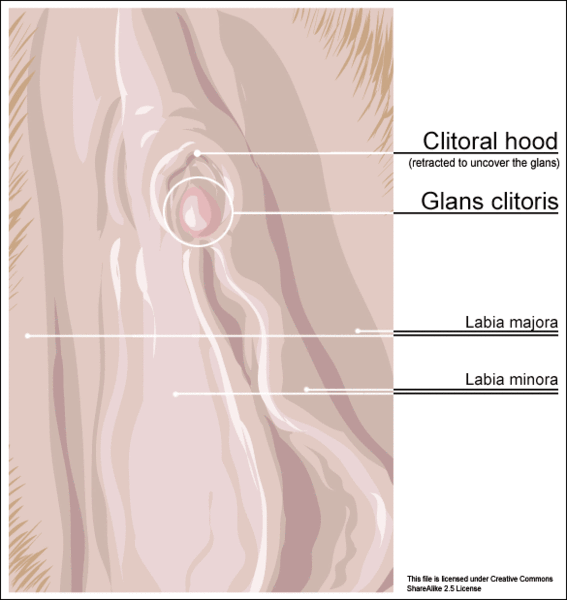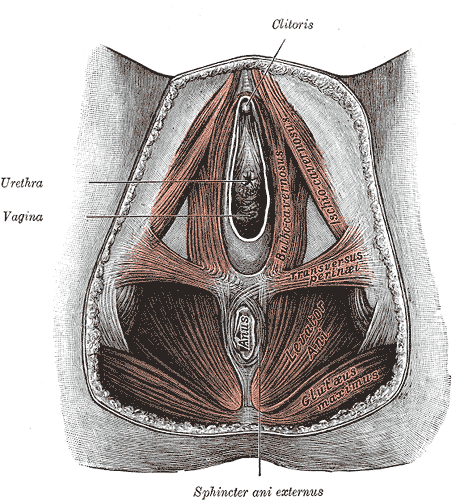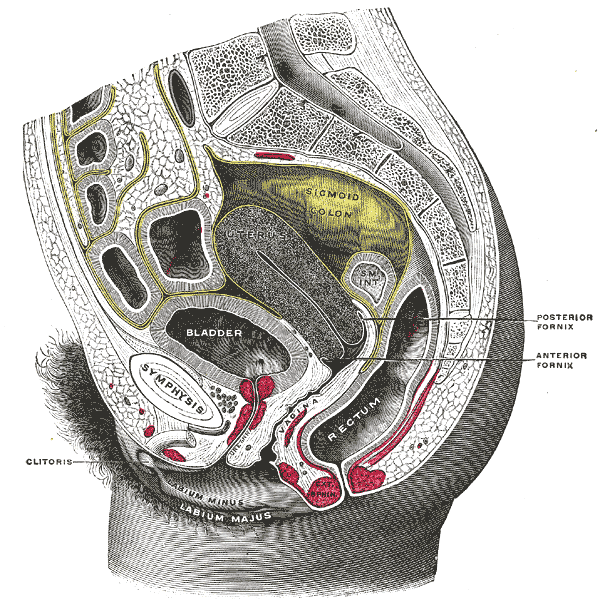Clitoris
|
WikiDoc Resources for Clitoris |
|
Articles |
|---|
|
Most recent articles on Clitoris |
|
Media |
|
Evidence Based Medicine |
|
Clinical Trials |
|
Ongoing Trials on Clitoris at Clinical Trials.gov Clinical Trials on Clitoris at Google
|
|
Guidelines / Policies / Govt |
|
US National Guidelines Clearinghouse on Clitoris
|
|
Books |
|
News |
|
Commentary |
|
Definitions |
|
Patient Resources / Community |
|
Directions to Hospitals Treating Clitoris Risk calculators and risk factors for Clitoris
|
|
Healthcare Provider Resources |
|
Causes & Risk Factors for Clitoris |
|
Continuing Medical Education (CME) |
|
International |
|
|
|
Business |
|
Experimental / Informatics |
Overview
The clitoris is a sexual organ that is present only in female mammals. In humans, the visible button-like portion is located near the anterior junction of the labia minora, above the opening of the urethra and vagina. Unlike the penis, which is homologous to the clitoris, the clitoris does not contain the distal portion of the urethra and functions solely to induce sexual pleasure. The only known exception to this is in the Spotted Hyena. In this species, the urogenital system is unique in that the female urinates, mates and gives birth via an enlarged, erectile clitoris, known as a pseudo-penis.[1]
Pronunciation and etymology
The word is Template:PronEng Template:Noprint) or Template:IPA Template:Noprint). The plural forms are clitorises in English and clitorides in Latin. In slang, it is sometimes abbreviated as clit, which originated in the 1960s. The Oxford English Dictionary suggests that the pronunciation Template:IPA) is also used in the UK, and gives the likely etymology as coming from the Greek Template:Polytonic, perhaps derived from the verb Template:Polytonic, to shut. The Online Etymology Dictionary maintains that the etymology of this diminutive is still uncertain noting that many sources take kleitoris “Template:Polytonic” literally from the Greek "little hill”. Other etymological candidates are key or latch, to touch or titillate lasciviously, to tickle, to be inclined (toward pleasure) and slope, from the same root as climax. It has been noted in German as der Kitzler meaning "the tickler". Its Latin genitive is clitoridis, as in "glans clitoridis".
Development and formation
At the time of development of the urinary and reproductive organs in embryogenesis the previously undifferentiated genital tubercle develops into the clitoris or the penis, along with all other major organ systems, making them homologous. [2]
Form
The head or glans of the clitoris is a simple bundle of 8000 nerve fibers, estimated to be twice the number found in the penis, [3]making it particularly well-suited for sexual stimulation.

The clitoris is a complex structure that includes external and internal components. Projecting at the front of the vaginal commissure where the edges of the outer lips (labia majora) meet at the base of the pubic mound is the clitoral hood (prepuce), which in full or part covers the head (clitoral glans) -- commonly about the size and shape of a shirt-button. Following from the head back and up along the shaft, it is found that this extends up to several centimeters before reversing direction, branched resulting in a shaped like an inverted "V", and extending as a pair of "legs" known as the clitoral crura formed of the corpora cavernosa, which are concealed behind the labia minora, and terminating attached to the pubic arch, according to some [1], or following interior to the labia minora to meet at the fourchette, according to others.[4]
Associated are the urethral sponge, clitoral/vestibular bulbs, perineal sponge, a network of nerves and blood vessels, suspensory ligaments, muscles and pelvic diaphragm.[2]
There is considerable variation with regard to how much of the clitoris protrudes from the hood and how much is covered by it, ranging from complete, covered invisibility to full, protruding visibility. An article published in the Journal of Obstetrics and Gynecology in July 1992 states that the average width of the clitoral glans lies within the range of 2.5 – 4.5 mm (0.10-0.18 in) indicating that the average size is smaller than a pencil eraser. There is no identified correlation between the size of a clitoris and the person's age, neither to being post-menopausal, nor to height, weight or use of oral contraceptives. Those who have given birth do tend to have slightly larger measurements.

Masters and Johnson were the first to determine that the clitoral structures surround and extend along the vagina, determining that all orgasms are of clitoral origin. [5] More recently, Australian urologist Dr. Helen O'Connell using MRI technology noted a direct relationship between the legs or roots of the clitoris and the erectile tissue of the clitoral bulbs and corpora, and the distal urethra and vagina. [6]She asserts that this interconnected relationship is the physiological explanation for the conjectured G-spot and experience of vaginal orgasm taking into account the stimulation of the internal parts of the clitoris during vaginal penetration. [7] Some individuals who experience orgasm from both direct clitoral stimulation of the glans and vaginal access to the internal bodies may distinguish between them in terms of both the physical and general sensations associated with each.
During sexual arousal and during orgasm, the clitoris and the whole of the genitalia engorge and change color as these erectile tissues fill with blood, and the individual experiences vaginal contractions. Masters and Johnson documented the sexual response cycle, which has four phases and is still the clinically accepted definition of the human orgasm. More recent research has determined that some can experience a sustained intense orgasm through stimulation of the clitoris and remain in the orgasmic phase for much longer than the original studies indicate, evidenced by genital engorgement and color changes, and vaginal contractions. [8]
Development
The clitoris is formed from the same tissues that would become the glans and upper shaft of a penis if the embryo had been exposed to “male” hormones. Changes in appearance of male and female embryos begin roughly eight weeks after conception. By birth, the genital structures have developed into the female reproductive system. [9] Embryo sex based on external genitalia is apparent to a doctor at the end of the 14th menstrual week, and the sex can usually be identified by an ultrasound after 16 to 18 menstrual weeks. [10]
Recognition of existence
Over a period of more than 2,500 years, some have considered the clitoris and the penis equivalent in all respects except their arrangement.[4] Medical literature first recognized the existence of the clitoris in the 16th century. This is the subject of some dispute: Realdo Colombo (also known as Matteo Renaldo Colombo) was a lecturer in surgery at the University of Padua, Italy, and in 1559 he published a book called De re anatomica in which he described the "seat of woman's delight". Colombo concluded, "Since no one has discerned these projections and their workings, if it is permissible to give names to things discovered by me, it should be called the love or sweetness of Venus."
Colombo's claim was disputed by his successor at Padua, Gabriele Falloppio who discovered the fallopian tube), who claimed that he was the first to discover the clitoris. Caspar Bartholin, a 17th century Danish anatomist, dismissed both claims, arguing that the clitoris had been widely known to medical science since the 2nd century. Indeed, Hippocrates used the term columella (little pillar). Avicenna named the clitoris the albatra or virga (rod). Albucasis, an Arabic medical authority, named it tentigo (tension). It was also known to the Romans, who named it landica. (The Latin Sexual Vocabulary by J.N. Adams Baltimore: The Johns Hopkins University Press, 1982. pp. 95-6.)
This cycle of suppression and discovery continued, notably in the work of De Graaf (Tractatus de Virorum Organis Generationi Inservientibus, De Mulierub Organis Generationi Inservientibus Tractatus Novus) in the 17th century and Kobelt (Die männlichen und weiblichen Wollustorgane des Menschen und einiger Säugetiere) in the 19th.
The full extent of the clitoris was alluded to by Masters and Johnson in 1966, but in such a muddled fashion that the significance of their description became obscured. That same year, feminist psychiatrist Mary Jane Sherfey published an article on female sexuality that described in detail the extensive nature of the internal anatomy of the clitoris and in 1981, the Federation of Feminist Women's Health Clinics (FFWHC) continued this process with anatomically precise illustrations. [4] Today, MRI complements these efforts, as it is both a live and multiplanar method of examination [11].
Female genital modification
The external part of the clitoris may be partially or totally removed during female genital cutting, also known as a clitoridectomy, female circumcision, or female genital mutilation (FGM); this may be a voluntary or involuntary procedure. The topic is highly controversial with many countries condemning the traditions that give rise to involuntary procedures, and with some countries outlawing even voluntary procedures. Amnesty International estimates that over 2 million involuntary female circumcisions are being performed every year, mainly in African countries.
In various cultures, the clitoris is sometimes pierced directly. In U.S. body modification culture, it is actually extremely rare for the clitoral shaft itself to be pierced, as of the already few people who desire the piercing, only a small percentage are anatomically suited for it; furthermore, most piercing artists are understandably reluctant to attempt such a delicate procedure. Some styles, such as the Isabella and the Nefertiti, do pass through the clitoris but are placed deep at the base, where they provide unique stimulation; they still require the proper genital build, but are more common than shaft piercings. Additionally, what is (erroneously) referred to as a "clit piercing" is almost always the much more common (and much less complicated) clitoral hood piercing.
Enlargement may be intentional or unintentional. Those taking hormones and/or other medications as part of female-to-male transition usually experience dramatic clitoral growth; individual desires (and the difficulties of surgical phalloplasty) often result in the retention of the original genitalia, the enlarged clitoris analogous to a penis as part of the transition. On the other hand, use of anabolic steroids by bodybuilders and other athletes can result in significant enlargement of the clitoris in concert with other masculinizing effects on their bodies. Temporary engorgement results from suction pumping, practiced to enhance sexual pleasure or for aesthetic purposes.
Intersex and transgender people
Transgender people who undergo sex reassignment surgery (male-to-female) may choose to have their surgeon design a clitoris, using their existing genital tissue. The new clitoris may be referred to as a neoclitoris.
Additional images
-
Outer anatomy of clitoris.
-
Muscles of the perineum.
-
Sagittal section of the lower part of the trunk, right segment.
References
- ↑ Laurence S. Baskina, Selcuk Yucelae, Gerald R. Cunhab, Stephen E. Glickmancd, Ned J. Placec (January 2006). "A Neuroanatomical Comparison of Humans and Spotted Hyena, a Natural Animal Model for Common Urogenital Sinus: Clinical Reflections on Feminizing Genitoplasty". Journal of Urology. 175 (1): 276–283.
- ↑ 2.0 2.1 Francoeur, Robert T. (2000). The Complete Dictionary of Sexology. The Continuum Publishing Company. p. 180. ISBN 0-82640-672-6.
- ↑ Angier, Natalie (1999). Woman – An Intimate Geography. Anchor Books. p. 63. ISBN 0-38549-841-1.
- ↑ 4.0 4.1 4.2 Chalker, Rebecca (2000). The Clitoral Truth. Seven Seas Press. p. 1. ISBN 1-58322-473-4.
- ↑ Federation of Feminist Women’s Health Centers (1991). A New View of a Woman’s Body. Feminist Heath Press. p. 46. ISBN 0-929945-0-2.
- ↑ O'Connell, Helen, Anatomy of the Clitoris, J Urol. 2005 Oct;174(4 Pt 1):1189-95, PMID 16145367
- ↑ Mascall, Sharon, “Time for Rethink on the Clitoris”, BBC News. 2006 June |url=http://news.bbc.co.uk/1/hi/health/5013866.stm
- ↑ Bodansky, Vera and Steve (2002). The Illustrated Guide to Extended Massive Orgasm. Hunter House. ISBN 0897933621.
- ↑ Reinisch, Beasley, June and Ruth (1990). The Kinsey Institute New Report on Sex. St. Martin’s Press. ISBN 0312063865.
- ↑ Heffner, Linda (2001). Human Reproduction at a Glance. Blackwell Sciences, Ltd. ISBN 0632054611.
- ↑ "Anatomy of the Clitoris". The Journal of Urology. 174: 1189–1195. October 2005.
Template:Female reproductive system Template:Human anatomical features Template:Sex
als:Klitoris ar:بظر zh-min-nan:Chi-bai-íⁿ bs:Klitoris br:Ellig bg:Клитор ca:Clítoris cs:Klitoris cy:Clitoris da:Klitoris de:Klitoris dv:ކުޅަނދިލި el:Κλειτορίδα eo:Klitoro fa:چوچوله gd:Brillean gl:Clítoris ko:음핵 hr:Klitoris ilo:Muting id:Klitoris is:Snípur it:Clitoride he:דגדגן ku:Klîtorîs la:Clitoris lt:Varputė hu:Csikló mk:Клиторис ms:Kelentit nl:Clitoris no:Klitoris simple:Clitoris sk:Dráždec sl:Ščegetavček sr:Клиторис su:Itil fi:Häpykieli sv:Klitoris tl:Tinggil th:คลิตอริส uk:Клітор zh-yue:陰蒂


